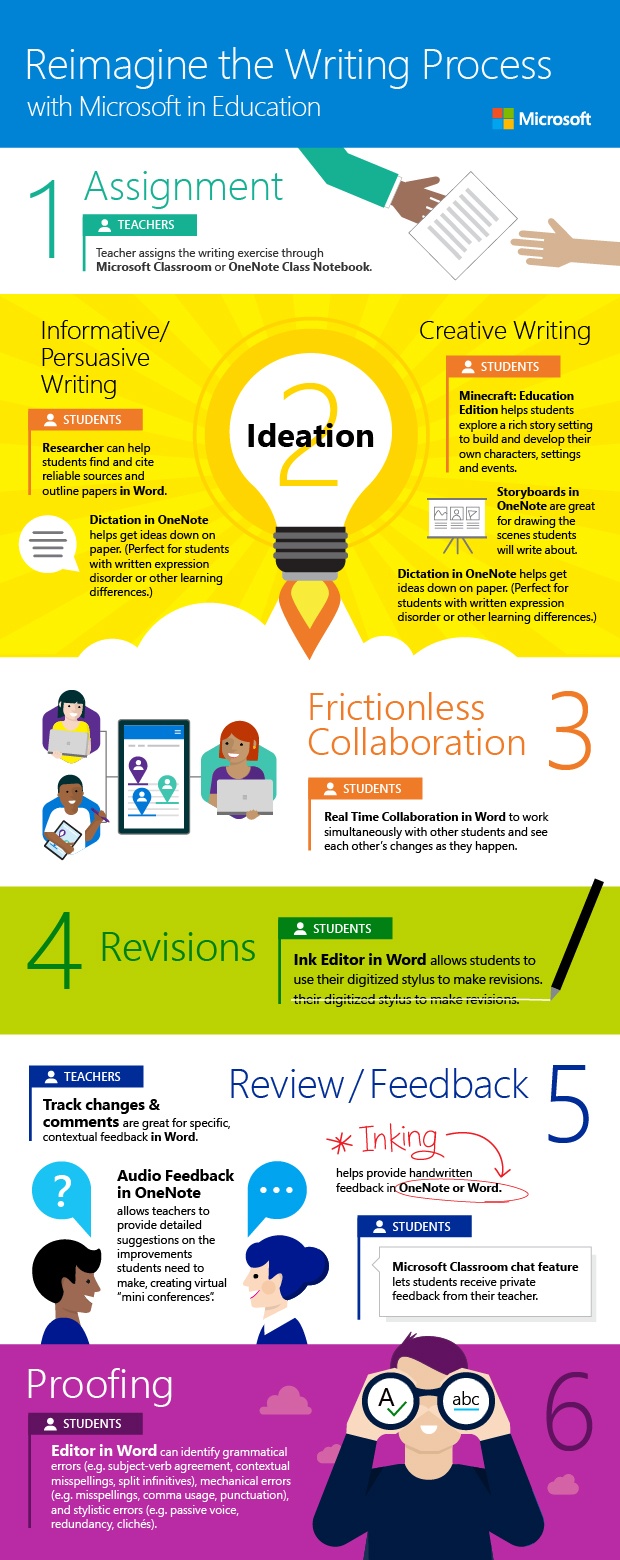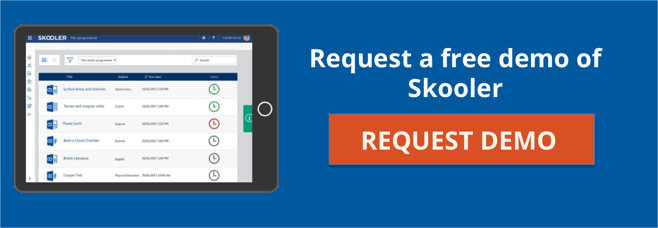This blog was originally published by Kelli Etheredge from Microsoft in April, 2017. You can read the original blog here.
Successful writers are not born. They learn by doing. They develop, practice, reflect. They receive feedback and grow. It’s a process. Teaching students the process is as important as the technical components of writing. The process helps students learn how to grow from a good writer to a great one.
In my seventeen years, teaching the writing process has slowly evolved with the use of technology. Only now, instead of small modifications in the process, the writing process itself is being reimagined, thanks to Microsoft.

Step 1: Assignment
The transformation of the writing process begins with how I assign the writing prompt to my students.
With Microsoft Classroom, I have a personalized homepage within Office 365 that allows me to manage all of my classes in one place. Each class is an Office 365 group that includes access to assignments, an Outlook calendar for scheduling events, a class discussion board, a OneNote Class Notebook, and a file storage for class materials. To add a writing assignment to my class homepage, I simply click New Assignment and then enter the details of the assignment and add a due date. I can even add a rubric to the assignment. Students will see the writing assignment within their Outlook calendar as soon as I enter it, reminding them of the due date every time they view their calendar. I can check the progress of students’ work as well, by clicking on the details of the assignment to see who has turned it in and who has not.
I can also post the writing assignment in my OneNote Class Notebook. Anything I can print to a printer, I can send to OneNote. Therefore, I can quickly post an existing document to OneNote detailing the writing assignment, as well as the rubric I will use to assess the student’s final product.
Whether I post the assignment in Microsoft Classroom or in the Content Library of my OneNote Class Notebook, I have no worries that students may lose the assignment. They can now access it anytime, anywhere.

Step 2: Ideation
Although ideation varies depending on the type of writing, Microsoft in Education provides wonderful tools to help students begin the magic of putting “pen to paper” and developing their ideas into organized, well-written papers.
One tool that crosses over both genres is the Dictation feature, found in Learning Tools for OneNote. With the dictation tool, students simply speak and OneNote does the typing. Dictation is not only a great way to combat the desperate stare at a blank, white page, but also a perfect accessibility feature for students with written expression disorder, dyslexia, dysgraphia, or other learning differences.
Researcher is the latest transformative tool for informative and persuasive writing assignments. Students no longer need to struggle with finding scholarly information or organizing it. For example, in an informative paper about the Amazon Rainforest, students can open the Reference tab in Word and click on Researcher to get started. In the search box, they simply type a keyword for the Amazon Rainforest and press Enter. They can then choose a topic from the results pane and select Add to create an outline for their paper. Once they have selected topics and organized them, students can select text, choose Add and Cite to add content from the research that’s automatically cited from the source. With Researcher, students will have an outline for their informative paper and scholarly sources, properly cited quickly and easily.

With creative writing assignments, visualizing the story students plan to write is a key component of producing a rich story. Two tools that help students develop their stories are Minecraft and Storyboarding with digital ink.
Minecraft allows students to build a virtual model of the creative world they envision. Within Minecraft, students can create the entire scene of their story, as well as the placement of the characters within that scene. In the Baddlands lesson, for example, students imagine their character, along with his or her home. Student Taylor E. shared his building plan as follows:
“My teacher asked me to create a home and farm that is personal to my character in the clearing outside Sawyer’s Saw Mill. I decided my character, Dustin, would live in front of and a little to the right of the Saw Mill. I built Dustin’s house using spruce and oak. I used spruce logs for the framing and spruce planks for a trim at the roofline. I used oak stairs to build a pitched roof and oak planks for the walls of the house. The house has two grand spruce doors for its entryway. I wanted Dustin’s house to look sturdy and be small. He is just a villager, so he wouldn’t have a lot. I plan to create a small garden beside his home with vegetables and create a pen for a few pigs.”
With Minecraft, Taylor was able to visualize his character’s home, station in life, and surroundings. He will find the process of creating his story easier now that he can see where and how Dustin lives.

In the planning stage of their creative writing, Storyboards can also help students create the visual as well as the narrative for their stories. Using their digitized stylus, students can draw the scene they are imagining and include a written description of the scene next to it. In The Inferno writing assignment, for example, students use their storyboards to plan out the new circle they will add to Dante’s Inferno, what happens in the circle, and what it looks like. In essence, the storyboards become the students’ first drafts of their creative paper, allowing them to sort out the details of the plot and characters before focusing on the mechanics and style.
Step 3: Frictionless Collaboration
If the writing exercise requires collaboration, Real Time Collaboration in Word is a wonderful tool for students. Students can work simultaneously in the document and see exactly where their peers are working and what changes they are making as they happen. That means no more worries of two students modifying the same section differently. They can now divide and conquer based on where their classmates are working.

Step 4: Revisions
One of my absolute favorite new tools in Microsoft’s toolset is Ink Editor in Word. Before Ink Editor, students would type their paper in Word, print their paper to make physical edits on the document, and then type the changes they made. Now, using a digitized stylus, Ink Editor allows students to make those physical changes to their document directly in Word, saving paper and time.

Step 5: Review/Feedback
Once students revise their paper, they are ready for feedback from me and their peers.
The Microsoft Classroom chat feature is a wonderful way for students to give their peers feedback on their writing. I always encourage students to share three things they like about their classmate’s piece and two things they feel their classmate could improve. This chat feature also allows teachers to provide private feedback to students on an assignment.
For me, I can make suggestions with the track changes and comment features in Word. Track changes is a helpful way to show students how to fix a grammatical error, while comments allows me to explain the grammatical error so that they can fix the same error in other places in their paper, or in the future. If a student has subject-verb agreement errors throughout his paper, for example, I typically correct one or two with the track changes feature and explain the error in the comments. Then, I tell the student how many more times the error occurs in the paper and encourage them to find the errors and correct them.

Inking in OneNote and Word is another useful way to provide feedback for my students. With my digitized stylus, I can provide feedback quickly just as if the students had printed the paper and given me a hard copy. For multiple revisions, Inking allows me to provide symbols and notes regarding items to improve without requiring much time on my part.
My absolute favorite tool for providing feedback to my students is the Insert Audio feature in OneNote. When students post their writing to their personal section of our Class Notebook, I am able to review it and add audio feedback to the page. Before using the audio feature in OneNote, I would meet with each student to discuss the strengths and weaknesses of their paper. Not only was the process time consuming (spanning over multiple days), students would frequently admit that they forgot some of what I shared with them, requiring a second meeting. Now, however, I am able to have mini-conferences with each student at the same time. Students listen to their audio feedback and I mill around the room and answer questions they may have. Students can replay the feedback as many times as needed and have expressed more confidence in their revisions as a result.
Step 6: Proofing
After review and feedback, students will, of course, conduct a final proofing of their paper on their own. Editor in Word offers students a virtual assistant for their writing. Editor identifies grammatical, mechanical, and stylistic errors, giving students complete confidence in their final submissions.

As an English teacher, the most important skill I can teach my students is the skill of effective communication. I am continuously examining ways I can improve my students’ communication skills. Microsoft in Education offers tools that help students with the writing process, making me a better teacher and my students better writers.
To learn more about how I use technology with my students, follow me on Twitter at @KEtheredge and use the hashtag #MicrosoftEDU. I have created both an Informative Writing Assignment on “Our Environmental Concerns” and Creative Writing Assignment on “Jumbled Stories” to get you started today on the Microsoft Educator Community. Plus, we have a BONUS lesson, Collaborative Writing Assignment on “Our Own Epic,” if you want your students to write a creative piece collaboratively. As always, we have more educator stories and use cases to talk about, so follow Microsoft Education on Twitter.

This blog was originally published by Kelli Etheredge from Microsoft in April, 2017. You can read the original blog here.


